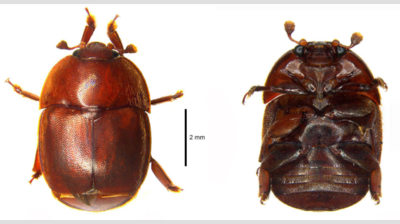- News
- City News
- kolkata News
- Invasive Small Hive Beetle detected in West Bengal: A new threat to India's honey bee industry
Trending
Invasive Small Hive Beetle detected in West Bengal: A new threat to India's honey bee industry
A young scientist from the Zoological Survey of India has discovered the invasive Small Hive Beetle (SHB) in an apiary in West Bengal, marking its first recorded instance in India. This invasive species poses a threat to the country's honey bee population and apiculture industry due to its rapid spread and destructive nature.
KOLKATA: A potentially devastating threat to India's honey bee population and apiculture industry has been uncovered by a young scientist from the Zoological Survey of India (ZSI) Jhikmik Dasgupta recently identified the presence of the invasive Small Hive Beetle (SHB), Aethina tumida, in an apiary located in Amdanga, North 24 Parganas district of West Bengal — marking the first recorded instance of the beetle in the country.
The discovery, published in the Journal of Environment and Sociobiology, raises alarms about the serious ecological and economic implications of this alien species, which is known for its ability to rapidly multiply and spread across regions. SHB is classified as an "Invasive Alien Species," a category of non-native organisms that pose significant threats to biodiversity and local ecosystems.
Dasgupta warns that the beetle's presence could severely impact India's beekeeping sector. “The Small Hive Beetle is a notorious enemy of honey bees and has caused widespread damage to the apiculture industry globally,” she said. “If not addressed quickly, it can jeopardise both honey production and the livelihoods of thousands who depend on it.”
Adult SHBs are small, oval-shaped beetles measuring 5–7 mm in length, typically reddish-brown in color. Female beetles infiltrate hives through cracks, laying eggs that hatch into larvae which feed on stored pollen, honey, and bee brood. Their activity contaminates honey, rendering it unsuitable for human consumption, and often leads to the collapse of bee colonies.
India’s eco-climatic conditions may prove favorable for the SHB’s proliferation, making early detection and response critical. “Invasive species like SHB are system-level disruptors,” Dasgupta explained. “They threaten not only native bee populations but also the essential ecological interactions that underpin our biodiversity.”
In response to this discovery, Dasgupta has initiated laboratory studies on the biology of SHB, aiming to develop biosecurity measures to curb its spread and mitigate its impact.
As India grapples with this emerging threat, experts stress the urgent need for coordinated monitoring, containment strategies, and awareness campaigns to protect native pollinators and safeguard the future of the country’s apiculture industry.
End of Article
FOLLOW US ON SOCIAL MEDIA










